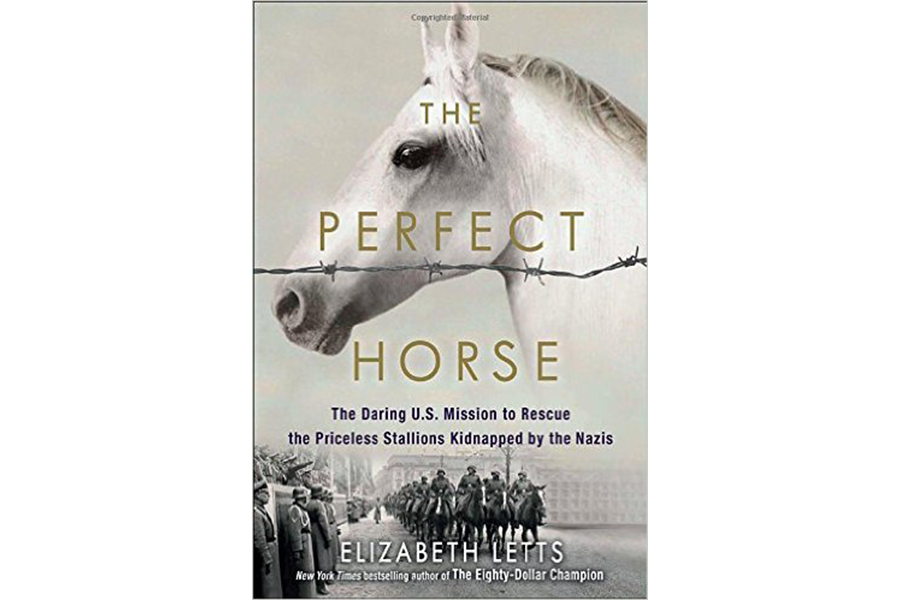'The Perfect Horse' is the perfect World War II rescue story
Loading...
When First Lady Jacqueline Kennedy visited the famed Spanish Riding School in Vienna and watched a performance of the Lipizzaner stallions in the summer of 1961, she sat prim and upright as always, aware that the eyes of the Cold War-weary world were on her. The audience marveled at the stylized rearing-and-jumping known as courbette, and at the spectacular flying leap called the capriole, and the First Lady, herself an avid horsewoman, applauded as enthusiastically as everybody else. But when the school's director, Alois Podhajsky, gave her a tour of the stables and introduced her to the horses, her veneer of diplomatic reserve crumbled instantly. There's blurry newsreel footage of the moment: She looks as giddy as a schoolgirl. “They're like something out of a fairy tale,” she remarked later to a friend, wonder still fresh in her voice.
Podhajsky would have agreed with the comment. He had fought for the horses under grubby conditions far removed from any fairy tale, back in 1939 when the school was at one of the lowest ebbs in its centuries-long history. And he lived with the horses through exile, chaos, and gunfire in the darkest days of World War II, particularly when the Nazis insisted on keeping the Lipizzaners in Vienna even at the height of Allied air raids on the city in 1944.
The story of those dark days is given a winningly readable treatment in The Perfect Horse, the new book by Elizabeth Letts, whose 2011 "The Eighty-Dollar Champion" made such indelibly wonderful reading. Letts tells the story of how Podhajsky (a man who “looked like he was born to sit astride a horse”) eventually won permission to evacuate the last 15 stallions from the bomb-ravaged city.
The horses made their way to the small town of Hostau in Bavaria, where they formed the nucleus of a secret Nazi stud farm under the distant oversight of Gustav Rau, the man in charge of all things horse-related in the Third Reich. Rau was tasked with rebuilding the breeding industry to serve a war effort still very much dependent on horses. He's the closest thing "The Perfect Horse" has to a classic villain, a hard man “quick to spot weaknesses in both men and horses,” and it was his dream to build a master-race of horses from the beautiful animals under Podhajsky's care.
In March of 1945, Hostau's director Colonel Hubert Rudofsky had a startling conversation with a Luftwaffe colonel who told him the Russian army was days, maybe hours, away, and who issued a warning guaranteed to chill the heart of any horse-lover: “I've spent time on the Eastern Front.... The Russians care nothing for horses – they will slaughter them on the spot and fry them up as steaks to feed their hungry troops. You are in the greatest danger, and you must act now to save them.”
The Russians were advancing, and the Third Reich was collapsing; there was only one path to take, and as unthinkable as it was, Rudofsky did if for the sake of his priceless horses: He went to the Americans.
Specifically to infamous General George Patton (“the one who got called in when the going got tough”) and brave, good-natured Major Hank Reed, whose task it was to rescue the Lipizzaners from the dangers closing in around them on all sides. Letts captures both the personalities and the stakes of this daring mission with such a sharp ear for drama that the whole second half of the book reads like a WWII thriller dreamed up by Alan Furst or Len Deighton. Reed knew that if he and his men failed, he would go down in history as “the most inept cavalryman ever let loose in Europe.”
As any of the millions of happy spectators who've seen the Lipizzaners in performance in the last 60 years can attest, Hank Reed did not fail. And thanks to Letts's moving, low-key writing, every touching moment of that triumph is rendered perfectly, including perhaps the most touching of all: At a show in Philadelphia in 1963, a civilian-dress Hank Reed entered the arena and walked up to Podhajsky, each remembering all the danger and hardship they'd endured to reach that point: “Forgetting all protocol, the two men, overcome with emotion, threw their arms around each other, and thunderous applause rose to the rooftops as the two former soldiers, who had once worn the uniforms of opposing nations, shared a heartfelt embrace.”
The idea of sending US soldiers to save a small group of aristocratic stallions was not without its critics at the time, especially military critics objecting to what they saw as yet another egotistical eccentricity on General Patton's part. But Reed and his men knew that something beautiful would have gone out of the world if their mission had failed. "The Perfect Horse" brings all the pathos and excitement of that mission to life again. The right director could make a Hollywood classic out of this fairy tale.








